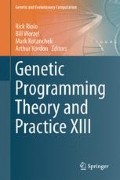Abstract
In this chapter we examine how multi-objective genetic programming can be used to perform symbolic regression and compare its performance to single-objective genetic programming. Multi-objective optimization is implemented by using a slightly adapted version of NSGA-II, where the optimization objectives are the model’s prediction accuracy and its complexity. As the model complexity is explicitly defined as an objective, the evolved symbolic regression models are simpler and more parsimonious when compared to models generated by a single-objective algorithm. Furthermore, we define a new complexity measure that includes syntactical and semantic information about the model, while still being efficiently computed, and demonstrate its performance on several benchmark problems. As a result of the multi-objective approach the appropriate model length and the functions included in the models are automatically determined without the necessity to specify them a-priori.
Access this chapter
Tax calculation will be finalised at checkout
Purchases are for personal use only
References
Affenzeller M, Winkler S, Kronberger G, Kommenda M, Burlacu B, Wagner S (2014) Gaining deeper insights in symbolic regression. In: Riolo R, Moore JH, Kotanchek M (eds) Genetic programming theory and practice XI. Genetic and evolutionary computation. Springer, New York
Breiman L, Friedman J, Stone CJ, Olshen RA (1984) Classification and regression trees. CRC Press, Boca Raton
Deb K, Pratap A, Agarwal S, Meyarivan T (2002) A fast and elitist multiobjective genetic algorithm: NSGA-II. IEEE Trans Evolut Comput 6(2):182–197
Dignum S, Poli R (2008) Operator equalisation and bloat free gp. In: Genetic programming. Springer, Berlin, pp 110–121
Friedman JH (1991) Multivariate adaptive regression splines. Ann Stat 19(1):1–67. https://projecteuclid.org/euclid.aos/1176347963
Keijzer M, Foster J (2007) Crossover bias in genetic programming. In: Genetic programming. Springer, Berlin, pp 33–44
Koza JR (1992) Genetic programming: on the programming of computers by means of natural selection. MIT Press, Cambridge, MA
Luke S (2000) Two fast tree-creation algorithms for genetic programming. IEEE Trans Evolut Comput 4(3):274–283
Luke S, Panait L (2002) Lexicographic Parsimony Pressure. In: Langdon WB, Cantu ′-Paz E, Mathias K, Roy R, Davis D, Poli R, Balakrishnan K, Honavar V, Rudolph G, Wegener J, Bull L, Potter MA, Schultz AC, Miller JF, Burke E, Jonoska N (eds) Proceedings of the genetic and evolutionary computation conference (GECCO’2002). Morgan Kaufmann Publishers, San Francisco, CA, pp 829–836
Poli R (2010) Covariant Tarpeian method for bloat control in genetic programming. Genet Program Theory Pract VIII 8:71–90
Poli R, Langdon WB, McPhee NF (2008) A field guide to genetic programming. Published via http://lulu.com and freely available at http://www.gp-field-guide.org.uk
Silva S, Costa E (2009) Dynamic limits for bloat control in genetic programming and a review of past and current bloat theories. Genet Program Evolvable Mach 10(2):141–179
Smits GF, Kotanchek M (2005) Pareto-front exploitation in symbolic regression. In: Genetic programming theory and practice II. Springer, Berlin, pp 283–299
Srinivas N, Deb K (1994) Multiobjective optimization using nondominated sorting in genetic algorithms. Evol Comput 2(3):221–248
Vanneschi L, Castelli M, Silva S (2010) Measuring bloat, overfitting and functional complexity in genetic programming. In: Proceedings of the 12th annual conference on genetic and evolutionary computation. ACM, New York, pp 877–884
Vladislavleva EJ, Smits GF, Den Hertog D (2009) Order of nonlinearity as a complexity measure for models generated by symbolic regression via Pareto genetic programming. IEEE Trans Evol Comput 13(2):333–349
Wagner S (2009) Heuristic optimization software systems - modeling of heuristic optimization algorithms in the heuristiclab software environment. Ph.D. thesis, Institute for Formal Models and Verification, Johannes Kepler University, Linz
White DR, McDermott J, Castelli M, Manzoni L, Goldman BW, Kronberger G, Jaskowski W, O’Reilly UM, Luke S (2013) Better GP benchmarks: community survey results and proposals. Genet Program Evol Mach 14(1):3–29. doi: 10.1007/s10710-012-9177-2
Acknowledgements
The work described in this paper was done within the COMET Project Heuristic Optimization in Production and Logistics (HOPL), #843532 funded by the Austrian Research Promotion Agency (FFG).
Author information
Authors and Affiliations
Corresponding author
Editor information
Editors and Affiliations
Rights and permissions
Copyright information
© 2016 Springer International Publishing Switzerland
About this chapter
Cite this chapter
Kommenda, M., Kronberger, G., Affenzeller, M., Winkler, S.M., Burlacu, B. (2016). Evolving Simple Symbolic Regression Models by Multi-Objective Genetic Programming. In: Riolo, R., Worzel, W., Kotanchek, M., Kordon, A. (eds) Genetic Programming Theory and Practice XIII. Genetic and Evolutionary Computation. Springer, Cham. https://doi.org/10.1007/978-3-319-34223-8_1
Download citation
DOI: https://doi.org/10.1007/978-3-319-34223-8_1
Published:
Publisher Name: Springer, Cham
Print ISBN: 978-3-319-34221-4
Online ISBN: 978-3-319-34223-8
eBook Packages: Computer ScienceComputer Science (R0)

